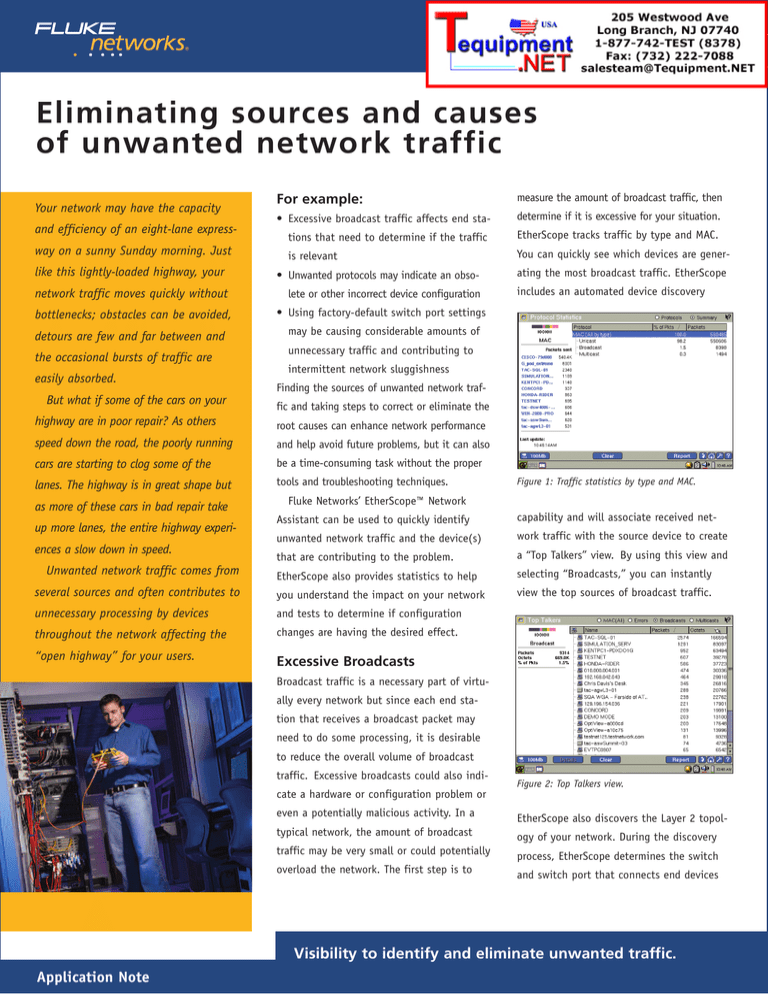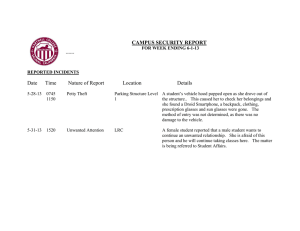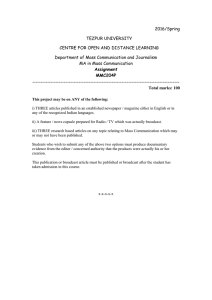
Eliminating sources and causes
of unwanted network traffic
Your network may have the capacity
and efficiency of an eight-lane expressway on a sunny Sunday morning. Just
like this lightly-loaded highway, your
For example:
measure the amount of broadcast traffic, then
• Excessive broadcast traffic affects end sta-
determine if it is excessive for your situation.
tions that need to determine if the traffic
EtherScope tracks traffic by type and MAC.
is relevant
You can quickly see which devices are gener-
• Unwanted protocols may indicate an obso-
network traffic moves quickly without
lete or other incorrect device configuration
bottlenecks; obstacles can be avoided,
• Using factory-default switch port settings
detours are few and far between and
may be causing considerable amounts of
the occasional bursts of traffic are
easily absorbed.
But what if some of the cars on your
intermittent network sluggishness
Finding the sources of unwanted network traffic and taking steps to correct or eliminate the
root causes can enhance network performance
speed down the road, the poorly running
and help avoid future problems, but it can also
cars are starting to clog some of the
be a time-consuming task without the proper
lanes. The highway is in great shape but
tools and troubleshooting techniques.
up more lanes, the entire highway experiences a slow down in speed.
Unwanted network traffic comes from
includes an automated device discovery
unnecessary traffic and contributing to
highway are in poor repair? As others
as more of these cars in bad repair take
ating the most broadcast traffic. EtherScope
Figure 1: Traffic statistics by type and MAC.
Fluke Networks’ EtherScope™ Network
Assistant can be used to quickly identify
capability and will associate received net-
unwanted network traffic and the device(s)
work traffic with the source device to create
that are contributing to the problem.
a “Top Talkers” view. By using this view and
EtherScope also provides statistics to help
selecting “Broadcasts,” you can instantly
several sources and often contributes to
you understand the impact on your network
view the top sources of broadcast traffic.
unnecessary processing by devices
and tests to determine if configuration
throughout the network affecting the
changes are having the desired effect.
“open highway” for your users.
Excessive Broadcasts
Broadcast traffic is a necessary part of virtually every network but since each end station that receives a broadcast packet may
need to do some processing, it is desirable
to reduce the overall volume of broadcast
traffic. Excessive broadcasts could also indi-
Figure 2: Top Talkers view.
cate a hardware or configuration problem or
even a potentially malicious activity. In a
EtherScope also discovers the Layer 2 topol-
typical network, the amount of broadcast
ogy of your network. During the discovery
traffic may be very small or could potentially
process, EtherScope determines the switch
overload the network. The first step is to
and switch port that connects end devices
Visibility to identify and eliminate unwanted traffic.
Application Note
to the network allowing you to take appro-
EtherScope only displays those protocols
Notification (TCN). This mechanism works
priate action which may include temporarily
that are actually detected to simplify the
very efficiently in a stable network and the
disabling the switch port while the problem
display. If a packet cannot be resolved to a
presence of TCNs is normally not an issue.
is being investigated.
known port number, it is sorted into an
A problem that can cause unexpected
“other” category, for example “Other TCP.”
consequences is when the spanning tree is
This helps locate users who may be running
enabled on ports that do change state fre-
undesirable applications or be infected with
quently. Since a TCN is generated when a
a virus.
port that was in the forwarding state goes
The device discovery feature in EtherScope
down or when a port transitions to the for-
includes a mechanism that can greatly
warding state, including each time an end
enhance the results when used within net-
user connects to the network, the TCN
works that utilize a management or adminis-
process starts and affects each bridge in the
Unwanted Protocols
trative VLAN for segregating user data from
spanning tree. In the worst case of a large
As networks and the services they provide
infrastructure traffic. Normally devices in a
network with many users connecting and
evolve and servers or user machines are
different VLAN are not visible to the discov-
disconnecting, the network can be in topol-
replaced and upgraded, the likelihood of pass-
ery processes. By allowing users to create a
ogy change status almost constantly. The
ing unwanted, often obsolete protocols within
list of devices in the management VLAN,
impact on the network is that the bridge
the network increases. Each situation is
EtherScope can provide a complete Layer 2
forwarding aging time (nominally 5 minutes)
unique, but knowing where to look and having
connectivity picture through switches to end
is reduced to an effective 15 seconds which
a tool that shows not only which devices are
user devices making it easier to locate
can lead to a very high level of flooding as
using a particular protocol but where they are
sources of unwanted protocols.
switches re-learn each link.
Figure 3: Top Talker nearest switch detail.
If you want to change a factory default
connected to the network is critical.
switch port setting, you can use
EtherScope monitors all network traffic
and automatically provides protocol statis-
Figure 5: Device details.
functionality to access the switch and set
tics for an extensive list of protocol types
and TCP and UDP ports. Combining protocol
statistics with device discovery provides a
simple way to determine what protocols are
running on your network and who is using
them. Click on the offending protocol to
locate the top source devices. Click on a
device to locate the offender on your network.
EtherScope’s Telnet or Terminal Emulator
Factory Default Switch
Configurations
port configurations. Consult your switch
documentation for the applicable switch
configuration commands.
Unwanted network traffic and even temporary network problems can occur as a side
effect of factory default settings in a normally healthy network. Consider SpanningTree Protocol (STP) used in almost every
switched network. Most vendors enable
spanning tree on each switch port by
default. This is a reasonable choice as it
makes it easy to quickly connect a new
Figure 6: Access telnet or terminal emulator
device and also protects the network from
functionality to change switch configurations.
forwarding loops as the network grows.
When the state of an interface changes, for
example connectivity to another switch is
Figure 4: Trace switch route.
lost, STP utilizes a special Bridge Protocol
Data Unit (BPDU) called a Topology Change
2
Conclusion
Unwanted network traffic is not only a nuisance to users, it can also cause confusion
when troubleshooting hard-to-find network
problems. Understanding the possible causes
and sources for unwanted traffic can be an
important part of keeping a network clean
and running efficiently. Combining the
knowledge of where and what to look for
with automated tools such as Fluke
Networks’ EtherScope Network Assistant
allows you to become a powerful problem
solver.
Visit www.flukenetworks.com/etherscope
to take a virtual demo of EtherScope or to
request a test drive on your network.
N E T W O R K S U P E R V I S I O N
Fluke Networks
P.O. Box 777, Everett, WA USA 98206-0777
Fluke Networks operates in more than 50 countries
worldwide. To find your local office contact details, go
to www.flukenetworks.com/contact.
©2005 Fluke Corporation. All rights reserved.
Printed in U.S.A. 2/2005 2435321 A-ENG-N Rev A




